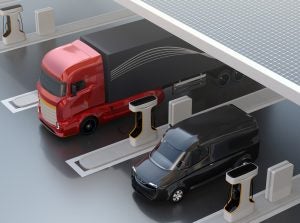 We should thank Ford, GMC and Tesla for capturing the world’s attention with flashy promotions of their upcoming all-electric F-150 pickup, Hummer and Cybertruck. If there’s one thing that will make you think differently about electric vehicles, it’s the image of a Hummer owner plugging in instead of filling up.
We should thank Ford, GMC and Tesla for capturing the world’s attention with flashy promotions of their upcoming all-electric F-150 pickup, Hummer and Cybertruck. If there’s one thing that will make you think differently about electric vehicles, it’s the image of a Hummer owner plugging in instead of filling up.
But when it comes to electric trucks, the consumer market is just the tip of the iceberg.
The electrification of the medium- and heavy-duty truck sector — everything from semis and delivery vans to transit buses and garbage trucks — is already underway, and analysts say it could spark a $47 billion global industry.
Every major truck and bus manufacturer is now developing at least one all-electric vehicle model or is part of an industry collaboration to bring zero-emission vehicles to market — a marked change in an industry that, just a few years ago, had only a handful of zero-emission options on offer.
Electrifying big trucks and buses could spark a $47B global market Share on XGlobal demand for socially responsible investments is accelerating, and record amounts of capital are ready to move off the sidelines — from impact-focused investors, to government stimulus and traditional lending and leasing structures.
Meanwhile, global companies are making fleet electrification a centerpiece of their sustainability plans. Walmart recently committed to 100% zero-emission trucks by 2040 and Amazon puts electric delivery trucks at the heart of the company’s net-zero carbon pledge.
All of this points to a powerful tipping point for electrifying trucks and buses that can deliver substantial financial, social and environmental returns for forward-thinking investors.
I discussed this exciting new trend recently with Richard Kauffman, Chair of the Board of Directors at Generate Capital, former New York “energy czar“ and trendsetter in the green finance universe. He sees massive opportunity and unmet challenges in this space.
“There are lots of exciting pieces coming together,” Kauffman said. “There’s plenty of capital out there to finance the electric fleet transition, technology costs have declined at an unprecedented rate, and there’s an excitement among policymakers, fleets and financiers to capture the market opportunity of this emerging sector. But to fit these pieces together, it requires these players to look at the whole picture.”
In other words, these new co-stakeholders need a common language and framework through which they can collaborate. For the finance community, for example, they see risk in providing capital to an emerging industry that’s still grappling with transition costs and business model uncertainties, like residual value. But government could play an important role in overcoming these barriers by engaging with the private sector to learn where there are market gaps.
“Government might act to stimulate the market by reducing soft costs or helping aggregate demand,” says Kauffman, who launched a $1 billion Green Bank in New York to help fund a clean, affordable and resilient electric system nearly a decade ago. “By acting as an incubator, government can take on some of the risks the private sector won’t while the market is maturing. But this requires a different way of thinking about financing than government saying, ‘We know what the problem is and we’re going to solve it by issuing a grant.’”
In addition to a common language and framework, Kauffman says, the key to transforming this market will be a new kind of collaboration. “Getting fleet electrification going isn’t rocket science. But it will require decision makers — people — to put the effort into understanding and using a common framework.”
A new report issued today by Environmental Defense Fund, MJ Bradley and Vivid Economics offers an important step toward that framework and collaboration. In it, we address the key barriers that still stand in the way of faster electrification and provide a toolkit of solutions that can help close the gap between traditional financing tools and what fleet owners need to make safe and sound financial decisions. We also lay out how all of these stakeholders — from fleet owners and capital providers, to local policy makers and electric utilities — can collaborate to close these gaps even faster.
Like Kauffman, I’m convinced that this little-discussed market segment can play a huge role in unlocking the climate and clean air benefits of electric vehicles. And we’re eager to spark the kind of collaboration he says it will take.









